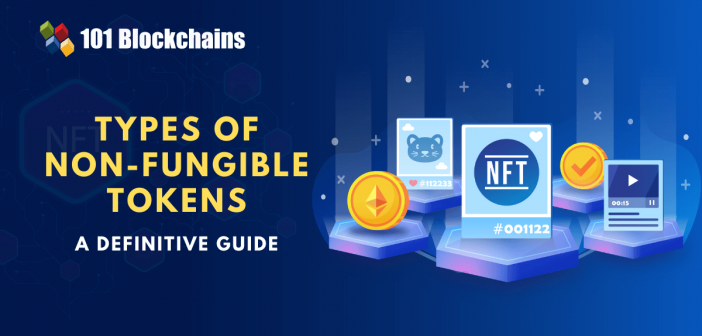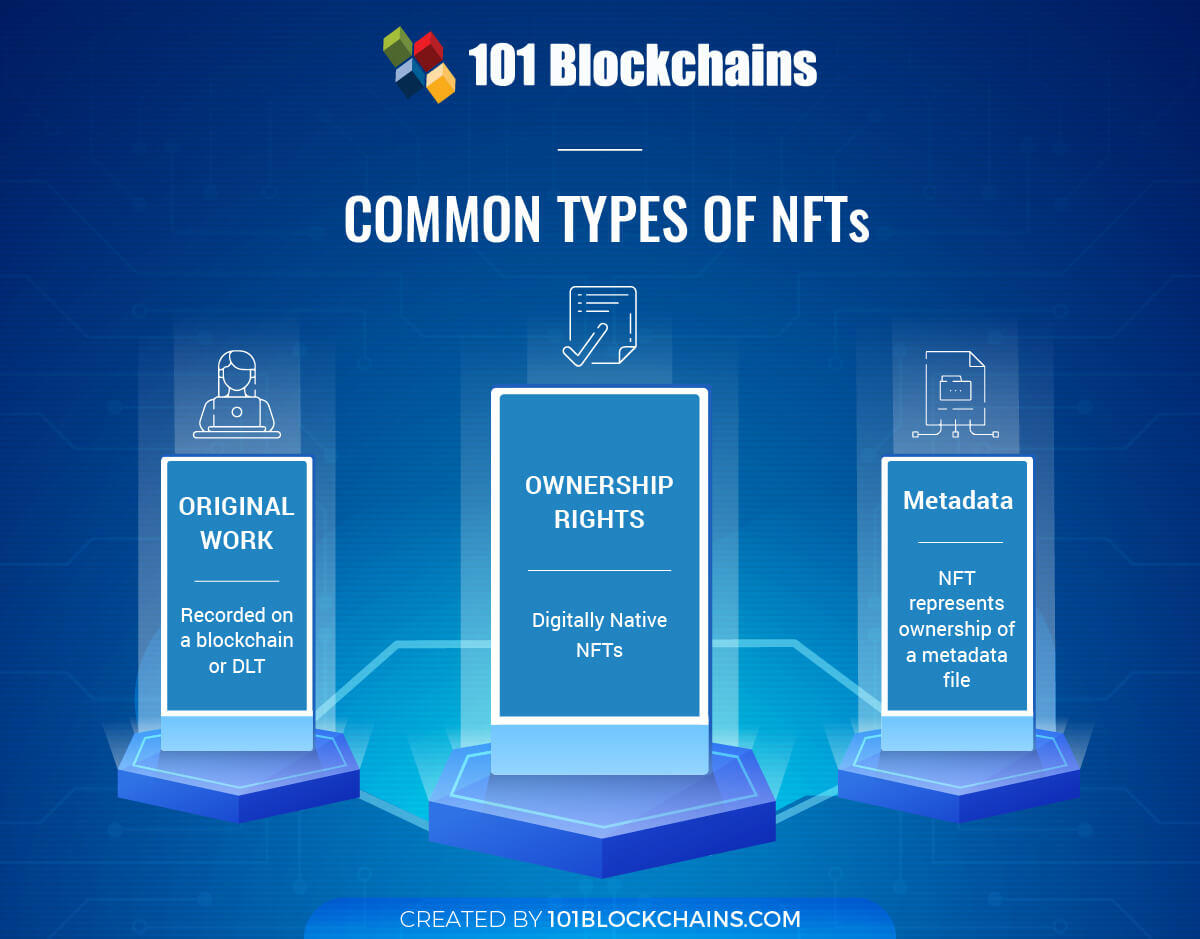Learn how blockchain truly works, master key definitions, and uncover what makes smart contracts so "smart." Dive into the fundamentals, gain valuable insights, and start your blockchain journey today!

- Guides
Diego Geroni
- on August 31, 2021
Understanding the Different Types of NFTs
Non-fungible tokens or NFTs are one of the notable topics garnering attention in 2021. The unique digital assets based on the foundation of blockchain technology have become quite popular in recent times. As a result, the interest in understanding the different NFT types has been growing in recent times. People are interested in the promising economic potential associated with NFTs apart from a vision for transforming conventional asset management. The gradual growth visible in the domain of non-fungible tokens can ensure prolific opportunities for NFT creators and investors. Therefore, a clear impression of the different types of non-fungible tokens could help in making better decisions in your NFT journey.
The Radical Rise of NFTs
Digital tokens are not something new in the world of technology. As a matter of fact, NFTs started to gain the attention of the world only after the digital artist Beeple auctioned off his artwork at a Christie’s auction in March 2021. Popular names such as Twitter chief Jack Dorsey and Elon Musk have also expressed their opinions in favor of NFTs.
It is interesting that the first NFT was minted in 2014, and only six years later, the NFT market cap is almost $2 billion, only in the first quarter of 2021.
In 2020, the total value of sales amounted to almost $250 million. NFTs are just digital or cryptographic tokens you can find on a blockchain with the ability to maintain uniqueness. NFTs could be tokenized variants of real-world assets or completely native digital assets.
Common Categories of NFTs
However, the association of NFTs with art is one of the prominent factors that can confuse many beginners in NFT. As a matter of fact, NFTs are not restricted only to the domain of art. You can discover different types of NFTs with unique traits and distinctive use cases.
The foremost classification of NFT types refers to the general categories. The three common types of NFTs include,
- Original or copy of work, documented on a blockchain network or DLT
- Digitally native NFTs, which have ownership rights to the work constituting the NFTs
- NFT metadata, which involves the NFT providing representation of ownership for metadata files related to the internet
The common types of non fungible tokens offer a broad description of the criteria used in the classification of NFTs. In the case of original NFTs, they are created on a blockchain network, and the NFTs remain on the blockchain network. Digitally native NFTs are the assets that involve issuing NFTs to multiple persons with ownership rights of the asset. The NFT metadata is another important pointer for the classification of non fungible tokens as it basically involves a link to the metadata for the NFT. As a result, you don’t get ownership of the NFT and just the right to use it.
Get familiar with the basic and advanced Non-Fungible Token (NFT) terms with the NFT Flashcards
What Are The Different Types of NFTs?
The different speculations regarding the potential of NFTs and the value and risks associated with them have become quite significant topics of discussion. Non fungible tokens are capable of displaying the true provenance of an asset with the functionalities of blockchain. NFTs could help in holding, limiting, or denying access to the rights of an individual on their assets, thereby ensuring exclusivity.
The developing infrastructure and growing scope for innovation in the domain of NFTs can foster their applications in diverse sectors. Therefore, it is reasonable to expect the emergence of new types of NFTs. As of now, you can take a look at some of the notable NFT types that are popular in present times.
The prominent entries in a non fungible tokens list would include the following,
- Collectibles
- Artwork
- Event tickets
- Music and media
- Gaming
- Virtual items
- Real-world assets
- Identity
- Memes
- Domain names
Want to get an in-depth understanding of non-fungible tokens (NFTs)? Enroll Now in NFT Fundamentals Course.
Let us take an overview of these different non fungible token or NFT variants to understand their significance.
-
Collectibles
The foremost example of NFTs emerged with the development of Cryptokitties, which are online collectibles. As a matter of fact, Cryptokitties are the first instance of people using NFTs. Interestingly, Cryptokitties became so popular in 2017 that they congested the Ethereum network. Cryptokitties are one of the striking additions to non fungible tokens list in the category of digital collectibles. They are basically digital kittens with distinct traits that make them more popular and favorable than others.
-
Artwork
Artwork is also another prominent candidate for NFTs. The common types of non-fungible tokens in this domain refer to programmable art, which features a unique concoction of creativity and technology. Currently, there are many limited edition artwork pieces in circulation with the scope for programmability under certain conditions. The use of oracles and smart contracts could help artists create images that are represented on blockchain networks. Digital art NFTs have also encouraged possibilities of participation from the legacy arts industry.
The tokenization of real-world assets and artwork could help in encouraging the adoption of NFTs. The possibilities of combining blockchain and IoT together could offer interesting prospects for scanning a code or sticker on assets. The NFT types in artwork could ensure that users could easily register ownership of real-world artwork on a blockchain network. Subsequently, users could also find out the complete history of an artwork, such as previous ownerships and the prices for which they were sold in the past.
Want to know more about tokenization? Enroll Now in Tokenization Fundamentals Course
-
Event Tickets
Another promising addition among the types of NFTs would refer to event tickets. Such types of NFTs allow people attending events such as music festivals and concerts to verify their identity and tickets. Event managers could mint a specific number of NFT tickets on a selected blockchain platform. Customers could purchase the tickets through an auction and store them in their wallets with easy accessibility through mobile devices.
-
Music and Media
The domain of music and media is also trying out experiments with NFTs, thereby leading to another category of NFTs. It is possible to link music and media files to NFTs, thereby enabling an individual with a true ownership claim to access the files. The two prominent platforms which help artists in minting their songs as NFTs include Rarible and Mintbase.
While artists get the advantage of reaching out directly to their followers and new audiences, the listeners get a premium experience. The sense of exclusivity in purchasing NFT music is one of the foremost reasons for infusing traits of vintage vinyl records. The growth of music NFTs in the non fungible tokens list could offer reliable prospects for addressing the concerns of music piracy and intermediaries.
Start learning Non-Fungible Token with World’s first NFT Skill Path with quality resources tailored by industry experts Now!
-
Gaming
The common types of non fungible tokens in the domain of gaming are primarily focused on in-game items. NFTs have evoked profound levels of interest among game developers. They can offer the functionality of ownership records for in-game items, thereby driving the growth of in-game economies. Most important of all, NFTs in the gaming sector also focus on introducing a wide array of benefits for players.
While in-game collectibles were common requirements for a better experience of the games, NFTs have the potential to change their value. In-game items as NFTs could easily help in recovering money by selling it outside the game. On the other hand, game developers or the creators issuing NFTs could earn a royalty for every sale of items in the open marketplace.
-
Real-world Assets
Even though you cannot find many NFT types serving as tokens for real-world items, the progress in the NFT domain can make that happen. For example, many NFT projects are presently focusing on the tokenization of real estate alongside luxury goods. NFTs are basically deeds, and they can introduce the flexibility for purchasing a car or home with an NFT deed. Therefore, NFTs representing real-world assets can capitalize on the opportunities with cryptographic proof of ownership.
-
Identity
One of the crucial traits of non fungible tokens is scarcity. Every NFT is unique and cannot be interchanged with any other token. In the case of identity NFTs, the working is similar to that of event tickets NFTs. They can serve as unique identifiers, thereby serving as reliable support for identity management systems.
The common applications of identity-based NFTs could be evident in certifications and licensing. Minting certifications and licenses and NFTs for proving and verifying the records of an individual could change the identity management sector. In addition, identity-based NFTs could also ensure that individuals can store evidence of their identity without the risk of losing it.
-
Memes
The most significant advancement in the domain of NFTs in recent times is the sale of memes as NFTs. While being a part of popular culture and an instant favorite among internet users, memes have also been associated with NFTs. The sale of memes as NFTs showcases the potential for unique meme creators to participate in an evolving futuristic ecosystem.
-
Domain Names
The answer to ‘What are the different types of NFTs?’ would also refer to domain names, which have become popular recently. Decentralized Domain Name Services such as Unstoppable Domains and the Ethereum Name Service (ENS) are the top examples of domain name NFTs. ENS can help in translating long and complex user addresses into a flexible and friendly experience for users with easier onboarding.
Build your identity as a certified blockchain expert with 101 Blockchains’ Blockchain Certifications designed to provide enhanced career prospects.
Final Words
The existing entries in the non fungible tokens list clearly depict the potential of the NFT ecosystem. As a completely new category of digital or tokenized assets, NFTs are changing the conventional notions of asset usage and ownership. Therefore, you can find the common types of non fungible tokens focusing on what you actually get with an NFT. First of all, you can have an original NFT created and stored on the blockchain.
The second type of NFTs refers to digital natives in which multiple NFTs serve as parts of ownership rights to specific assets. The third category of NFTs only offers access to NFT metadata, thereby allowing you to use the NFT rather than allocating ownership. The different types of NFTs in circulation today, such as artwork, music, and media, domain names, memes, also show promising prospects for the future of NFTs.
*Disclaimer: The article should not be taken as, and is not intended to provide any investment advice. Claims made in this article do not constitute investment advice and should not be taken as such. 101 Blockchains shall not be responsible for any loss sustained by any person who relies on this article. Do your own research!







